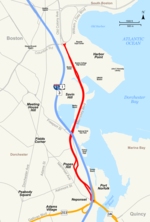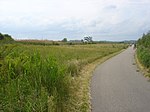Rainbow Swash
1971 paintingsArt in MassachusettsCulture of BostonDorchester, BostonLandmarks in Dorchester, Boston ... and 2 more
Murals in MassachusettsRainbows in art

The Rainbow Swash is the common name for an untitled work by Corita Kent in the Dorchester neighborhood of Boston, Massachusetts. The rainbow design painted on a 140-foot (43 m) tall LNG storage tank was copyrighted in 1972, and was claimed to be the largest copyrighted work of art at the time. Highly visible from daily commuters' drives on Interstate 93, it is considered one of the major landmarks of Boston, akin to the Citgo sign.
Excerpt from the Wikipedia article Rainbow Swash (License: CC BY-SA 3.0, Authors, Images).Rainbow Swash
Victory Road, Boston Dorchester
Geographical coordinates (GPS) Address Nearby Places Show on map
Geographical coordinates (GPS)
| Latitude | Longitude |
|---|---|
| N 42.301452777778 ° | E -71.045166666667 ° |
Address
Rainbow Swash
Victory Road
02122 Boston, Dorchester
Massachusetts, United States
Open on Google Maps







